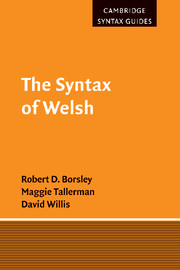9 - Historical syntax
Published online by Cambridge University Press: 01 October 2009
Summary
In this chapter, we turn to the historical development of Welsh syntax, concentrating mostly on the Middle Welsh period (1150–1500) to the present day. Welsh has undergone major changes in a number of areas, particularly in word order, negation and the syntax of embedded non-finite verbs. This chapter will give an overview of the main changes, as well as looking at some areas of syntax where the language has remained fairly conservative (agreement, wh-constructions, noun phrases). The major issues that will be considered are:
(i) the status of non-VSO word orders in Middle Welsh
(ii) the grammaticalization of aspect markers
(iii) the shift of negation from pre-verbal to postverbal position (Jespersen's Cycle)
(iv) the integration of mutation from phonology into syntax
(v) the spread of predicate marker yn and word-order changes in the syntax of the copula
(vi) the emergence of main-clause affirmative particles from earlier pronouns
(vii) the loss of an ‘ergative’ system of case-marking in embedded nonfinite clauses
(viii) the emergence of clauses introduced by the preposition i ‘to’
For reasons of space, it has not been possible to discuss every syntactic change. In particular, the emergence of dialectally specific grammatical items, such as the northern past-tense marker ddaru and the southern negative marker smo, will not be covered. The same applies to syntactic developments before the Middle Welsh period, and to some more minor developments in the Middle Welsh and modern periods (decline of subjunctive; reanalysis of os ‘if’ from a cleft marker to a complementizer) and so on.
- Type
- Chapter
- Information
- The Syntax of Welsh , pp. 286 - 337Publisher: Cambridge University PressPrint publication year: 2007



